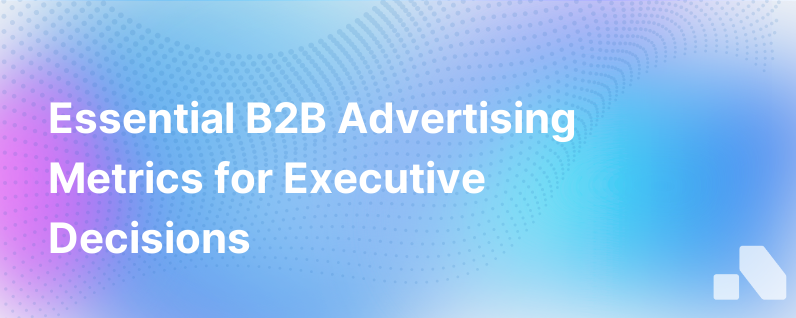
In the ever-evolving landscape of B2B advertising, the capacity to measure the impact and performance of your campaigns is not just beneficial, it’s imperative. Gone are the days of billboard advertising where success was measured by the number of passersby and possibly an upswing in sales. Today, in a world dominated by digital platforms, the metrics are many, the data is deep, and the insights are invaluable.
Understanding which measures are important – and why – can make the difference between a campaign that resonates and one that falls flat. This guide aims to shed light on the essential metrics for measuring B2B advertising effectiveness and how to apply these insights to optimize future campaigns.
Let’s dive into the anatomy of B2B advertising measurement and explore the core metrics that can propel your strategies forward.
The Anatomy of B2B Advertising Measurement
Why Measurement Matters in B2B Advertising
In the B2B sector, where sales cycles are lengthy and purchasing decisions are complex, measurement isn’t just a means of proving value; it’s a strategic tool. Digital marketing enables advertisers to track prospect interactions from the first ad encounter to the closed sale, and subsequent customer lifecycle events.
Accurate measurement delivers numerous benefits:
- It offers insight into customer journeys. You can identify which tactics engage and which ones deter, guiding your nurturance strategies.
- It drives budget efficiency. By understanding cost per acquisition (CPA) and return on ad spend (ROAS), you can allocate budgets to high-performing campaigns and channels.
- It enables performance benchmarking. From here, companies can establish clear goals and objectives for their marketing strategies.
- It facilitates agile marketing. Real-time data allows for on-the-fly adjustments to campaigns, reducing wasted spend on underperforming ads.
Key Metrics for B2B Advertising Measurement
1. Lead Generation Metrics
B2B advertising is fundamental in generating leads. As such, advertisers should zero in on metrics like:
- Lead Volume: The total number of leads generated. This top-of-funnel metric is a basic indicator of visibility and initial interest.
- Cost per Lead (CPL): The average cost spent to acquire a new lead. This financial metric helps to gauge the cost-effectiveness of campaigns.
- Lead Quality / Sales Qualified Leads (SQLs): Analyze how many leads are progressing to become SQLs, which signals a higher likelihood of conversion.
2. Conversion Metrics
Moving down the funnel, conversion metrics provide a view into how effectively leads become customers.
- Conversion Rate (CR): The percentage of leads that undertake a desired action, whether it’s filling out a form or signing up for a webinar.
- Cost per Acquisition (CPA): Like CPL, but focused on the cost associated with acquiring a paying customer which is a more significant metric for B2B.
- Sales Conversion Rate: Tracks what percentage of SQLs has turned into actual sales, giving insight into the effectiveness of your sales funnel.
3. Engagement Metrics
These metrics help you understand how your target audience is interacting with your ads and content.
- Click-Through Rate (CTR): Provides the ratio of users who click on a specific link to the number of total users who view an advertisement.
- Time on Site: Indicates engagement level by measuring how long visitors stay on your site.
- Content Engagement: Includes metrics such as shares, comments, and downloads of your content.
4. Return on Investment (ROI) Metrics
Perhaps the most important metric, ROI measures the ultimate profitability of advertising campaigns.
- Return on Ad Spend (ROAS): This measures the gross revenue generated for every dollar spent on advertising. Unlike ROI, it does not take into account the cost of goods sold.
- Customer Lifetime Value (CLV): Estimates the total revenue a business can expect from a single customer account throughout their relationship with the company.
5. Brand Perception Metrics
A more elusive but increasingly crucial set of metrics measures shifts in brand perception due to advertising efforts.
- Brand Awareness Lift: This measures the percentage increase in target audience awareness over a campaign period.
- Sentiment Analysis: Gauges the tone of the conversation around your brand pre- and post-campaign.
Applying Measurement Insights
These metrics are only as useful as the insights drawn and actions taken. Your data can power smarter campaigns by:
- Optimizing Ad Creative: Use engagement and conversion metrics to refine messaging and visuals.
- Adjusting Channel Strategies: Identify which platforms are delivering the best ROI and adjust spend accordingly.
- Improving Audience Targeting: Refine your targeting parameters based on performance data to better reach your ideal customers.
- Personalizing Follow-ups: Use behavior and engagement metrics to personalize nurturing campaigns for prospects.
In Summary
Data-driven decision-making is at the core of effective B2B advertising today. Understanding and leveraging the right metrics can enhance campaign performance, ensure budget efficiency, and most importantly, deliver scalable business growth.
For those leveraging platforms like Aomni, this process can be streamlined significantly. With powerful AI insights and real-time data analysis, Aomni gives you an edge in not just planning and executing campaigns, but in measuring and interpreting their success, helping you refine your B2B advertising initiatives with precision.